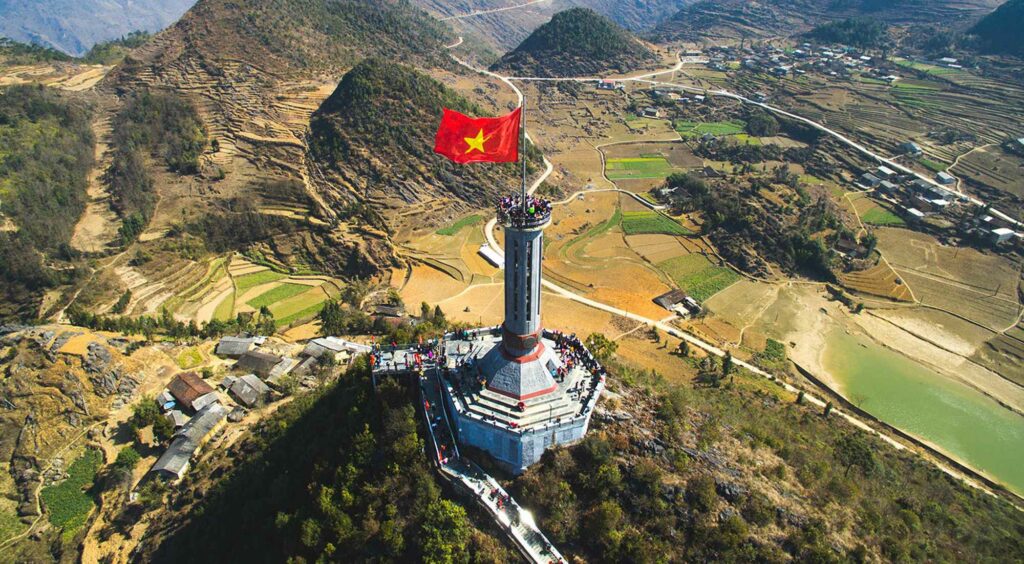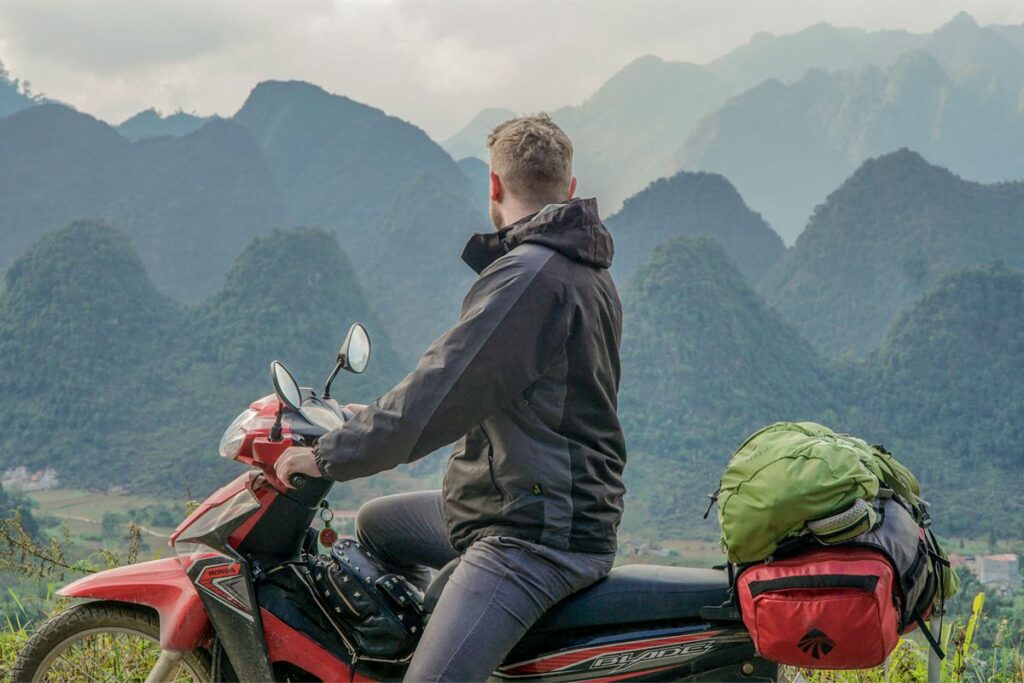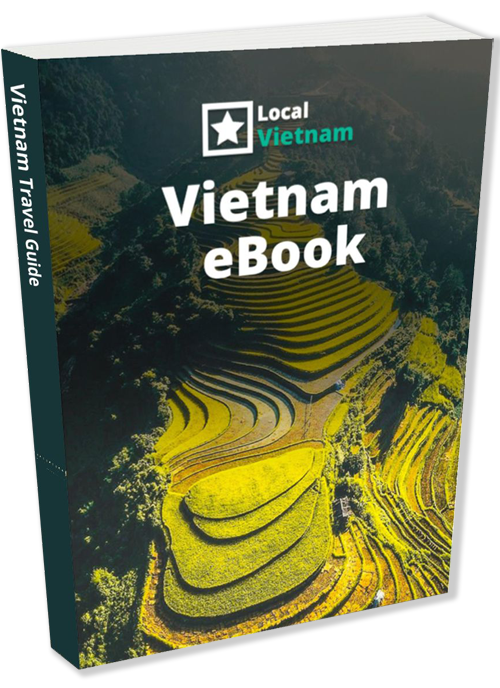Lung Cu – The Northernmost commune of Vietnam
Lung Cu is a commune in Dong Van District, Ha Giang Province, marking the most northern area of Vietnam. While the Lung Cu Flag Tower is the most famous attraction, this remote region is also home to several ethnic minority villages, where groups such as the Lo Lo and Hmong have lived for generations.
Scattered across the commune, these villages offer a glimpse into traditional highland life, with stilt houses, terraced fields, and local markets. Some of the villages have homestays, allowing visitors to experience rural life firsthand and explore beyond the main tourist stops.
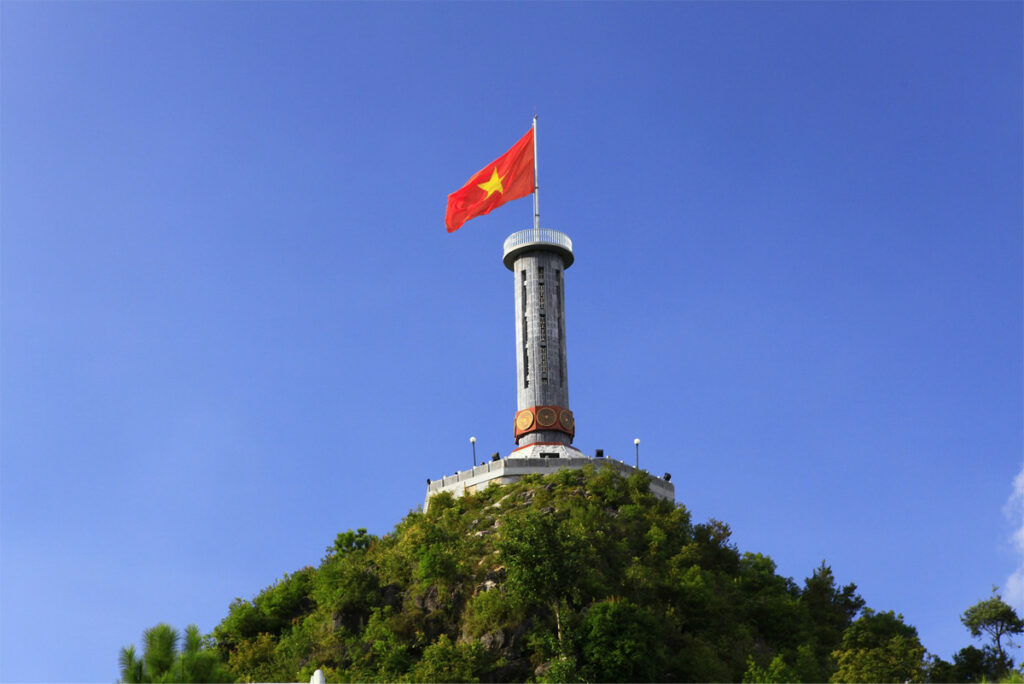
In recent years, a large temple complex has been built near Lung Cu, adding another point of interest to the area—though not without some controversy regarding its construction. Despite these modern additions, Lung Cu remains a rugged and historically significant destination, most often visited as part of the Ha Giang Loop, a scenic journey through Vietnam’s northernmost landscapes.
Lung Cu Flag Tower
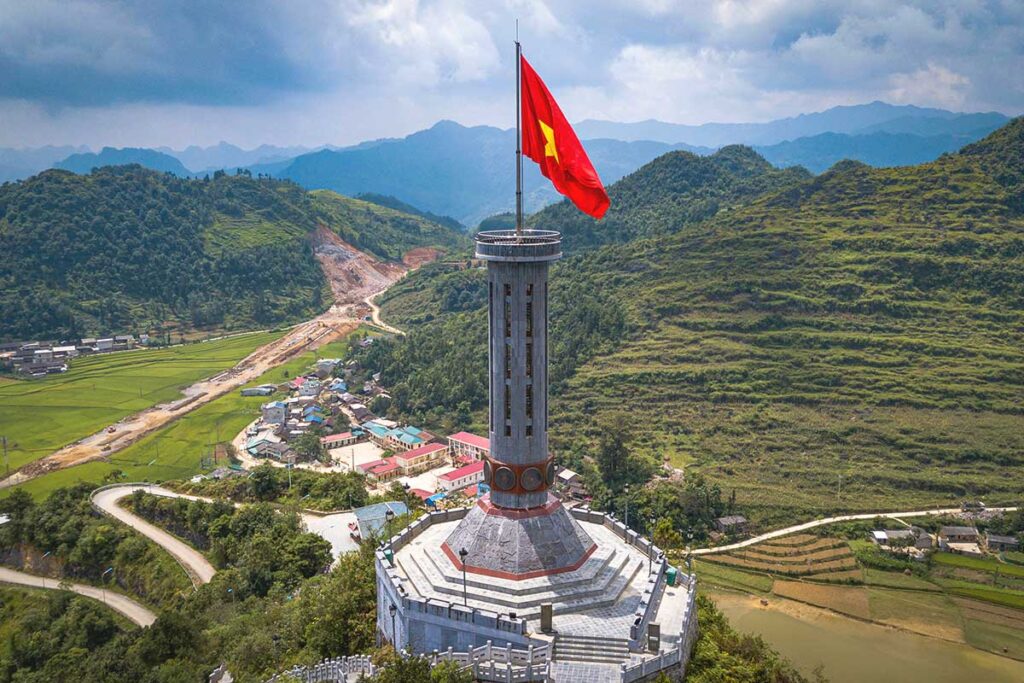
The Lung Cu Flag Tower is the most famous landmark in Lung Cu, standing as a symbol of national pride in Vietnam’s northernmost region. As you approach Lung Cu, the tower dominates the landscape, visible from miles away. While many refer to it as marking the northernmost point of Vietnam, the actual border with China lies about 4 km further north. There, a border marker indicates the true northernmost point accessible to visitors, though even from this marker, a river and hills still separate the two countries, and access beyond this point is restricted.
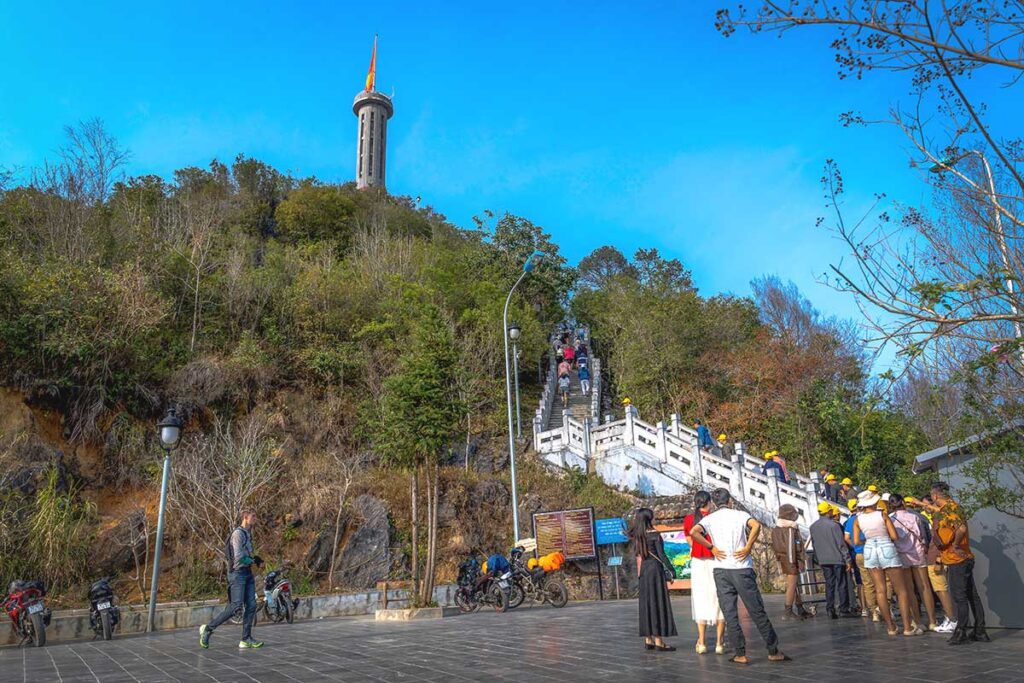
Located on Rong Mountain, at 1,700 meters above sea level, the flag tower itself stands 33 meters tall, topped with a 54-square-meter flag, representing Vietnam’s 54 ethnic groups. To reach the base of the tower, visitors must climb 839 stone steps, divided into three sections.
- By motorbike: You can drive up to the top parking area, leaving only 283 steps to climb.
- By car: You’ll need to take an electric buggy from the lower parking lot to the top parking area before walking the final steps.
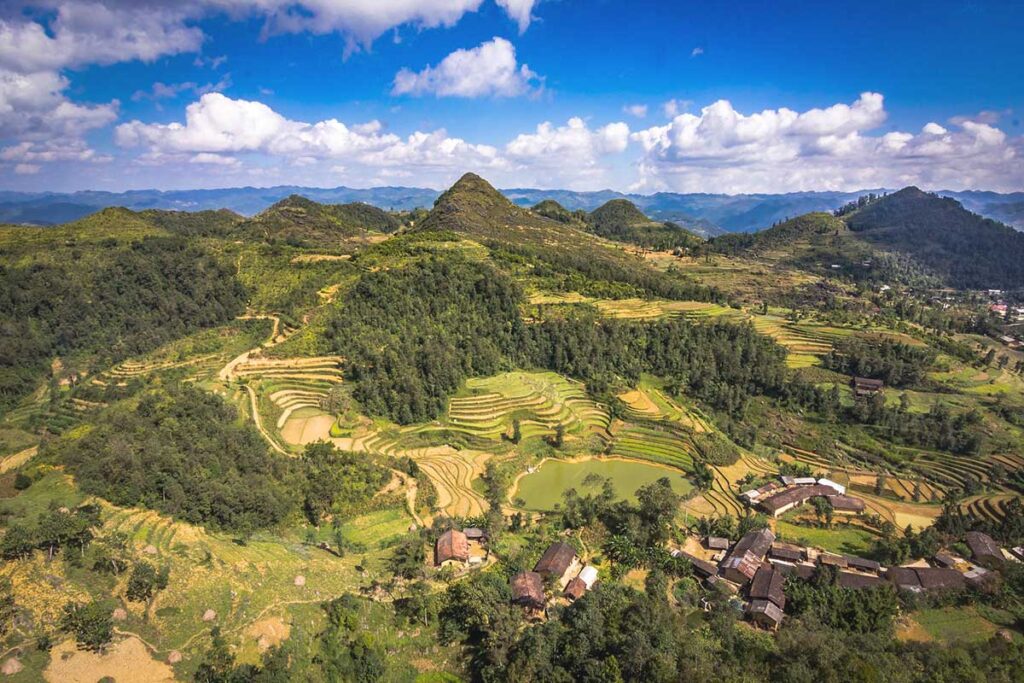
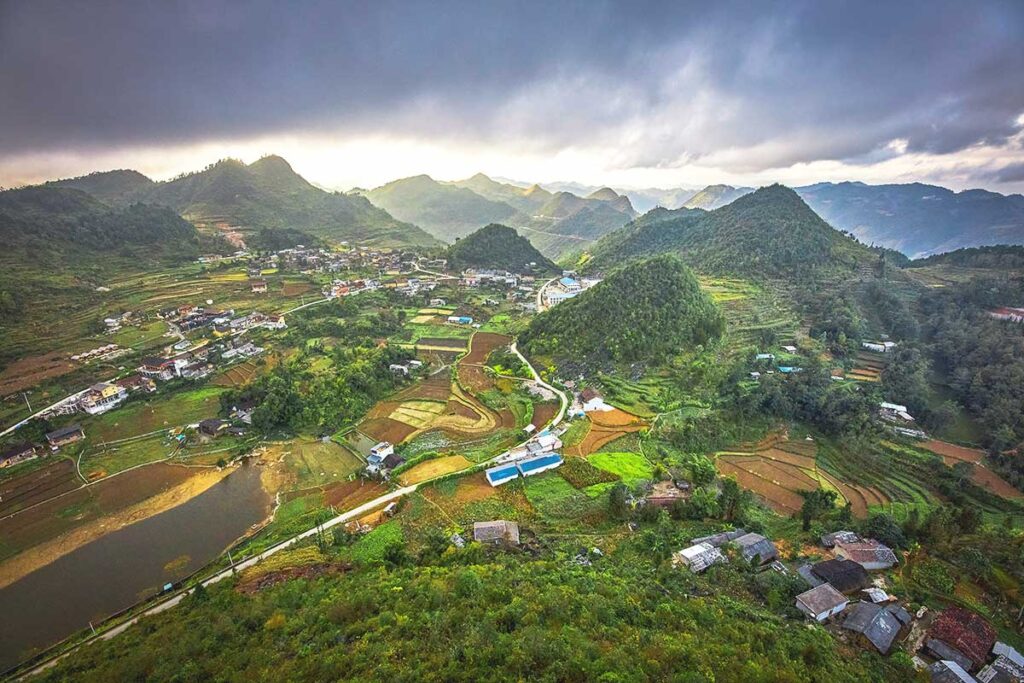
Once at the viewing platform, visitors are rewarded with panoramic views of Vietnam’s northern highlands and the mountains of China stretching into the distance.
Admission: 20,000 VND per person
Location: Find on Google Maps
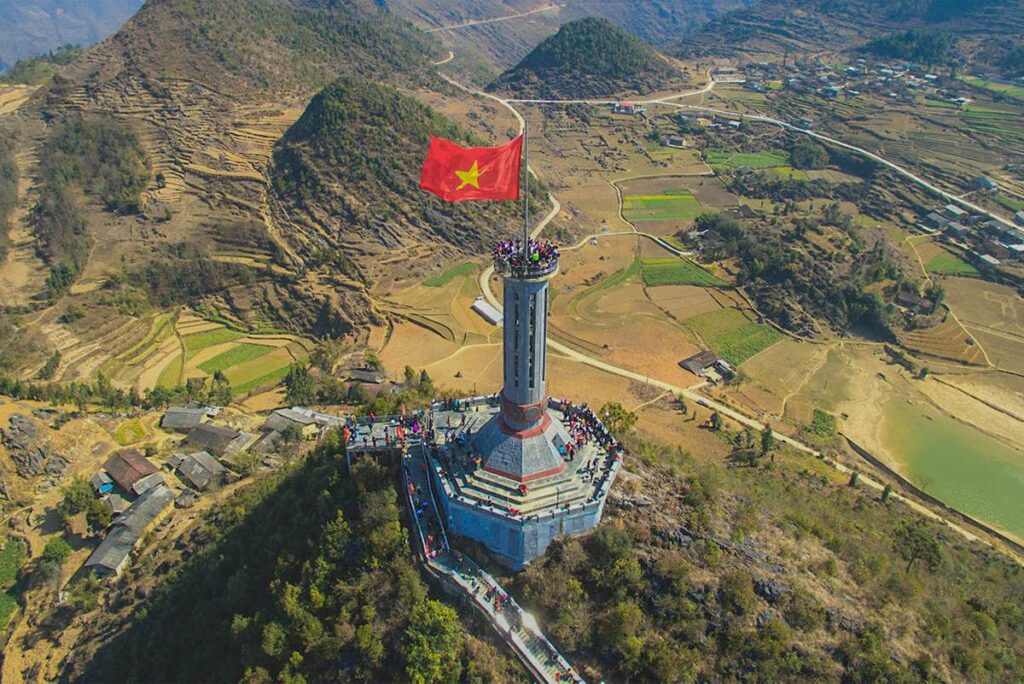
While there aren’t many facilities around the tower, you’ll find a few small shops and restaurants nearby for snacks and refreshments. A highly recommended stop is Cafe Cuc Bac, set in an authentic minority house, offering a cozy place to relax after the climb.
Ethnic life in Lung Cu Commune
Lung Cu is not just about the flag tower—it is also a commune made up of multiple ethnic villages, where minority communities have lived for generations. While the flag tower might be the most famous attraction, the true highlight of Lung Cu is its people, culture, and traditional way of life. Driving to Lung Cu from Ha Giang City via Sa Phin or from Dong Van, you’ll pass through some of Vietnam’s most breathtaking landscapes, with towering mountains on both sides and small ethnic villages scattered in the valleys below.
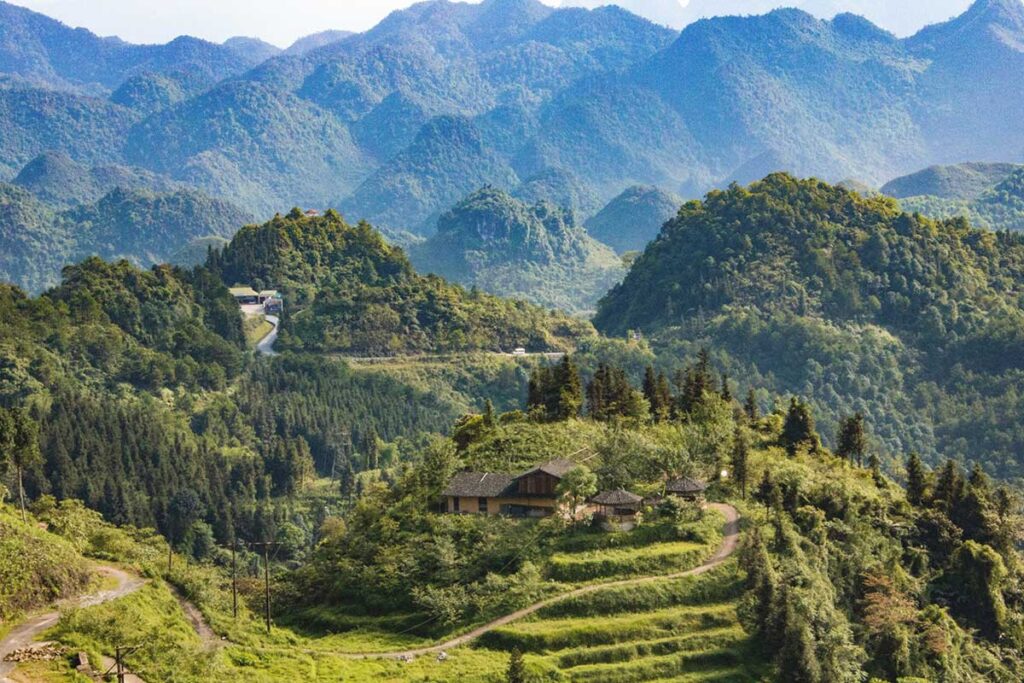
Lung Cu Commune is home to two main ethnic groups, the Lo Lo and Hmong people. These communities have preserved their rich cultural heritage, seen in their distinct clothing, unique houses, and traditional lifestyles. Some villages in Lung Cu offer homestays, allowing travelers to experience daily life, home-cooked meals, and local customs firsthand. Others remain untouched by tourism, offering a more authentic glimpse into traditional highland life.
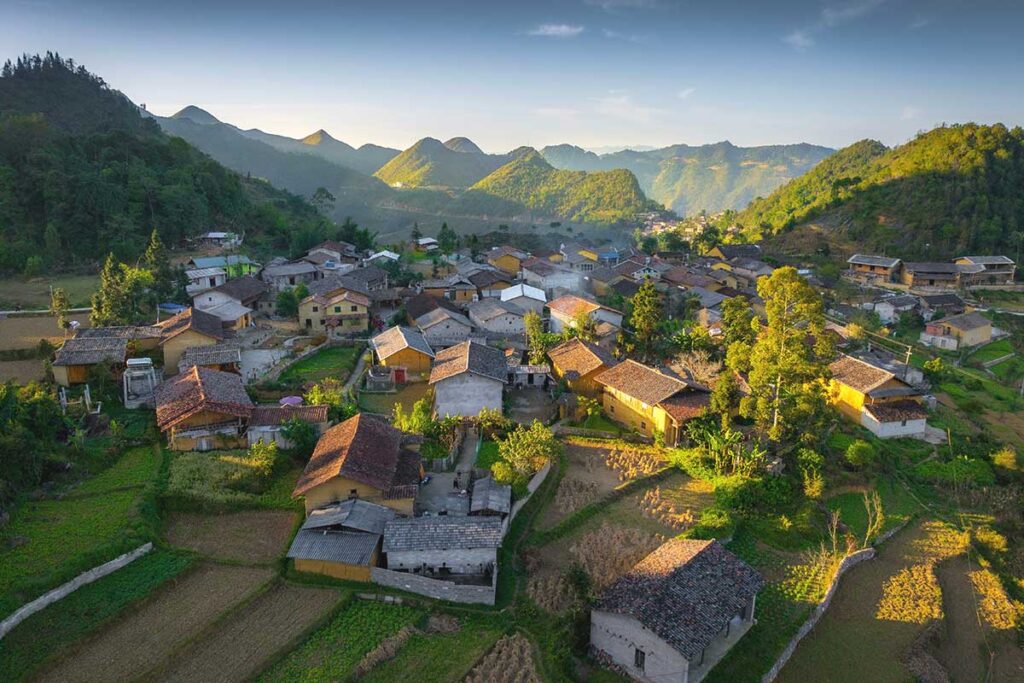
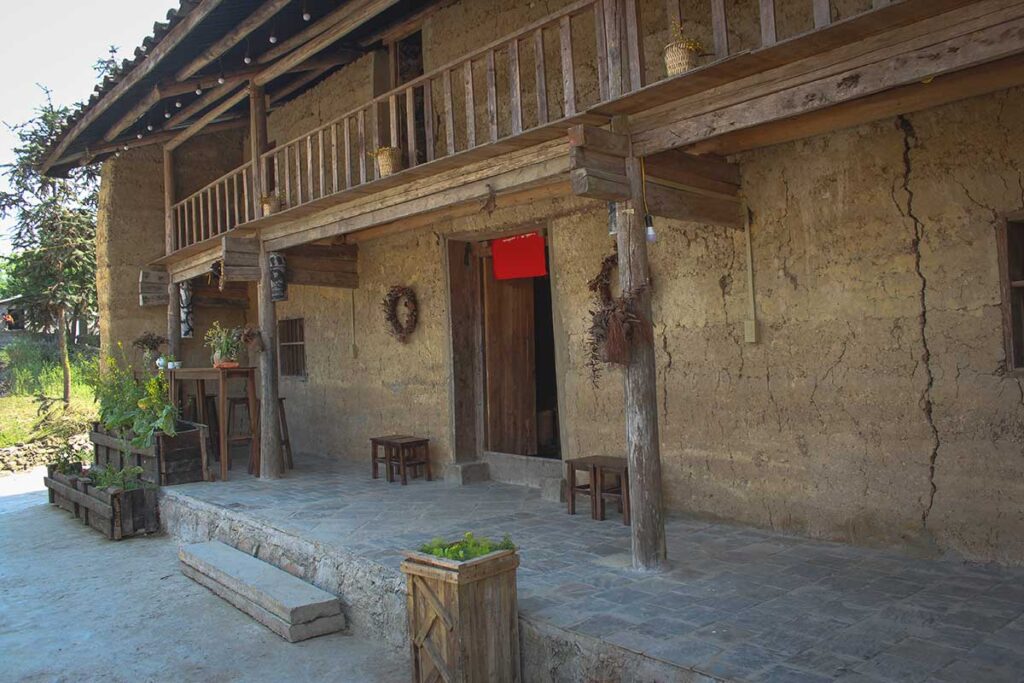
The ethnic groups of Lung Cu
Lo Lo People – One of Vietnam’s smallest ethnic groups
The Lo Lo people are among Vietnam’s smallest ethnic groups, with only around 3,000 individuals living in Ha Giang and a few other northern provinces. They are known for their vibrant, handwoven clothing, often decorated with intricate patterns and bright colors. Traditionally, Lo Lo women wear layered skirts and embroidered jackets, while men wear simple indigo-dyed outfits.
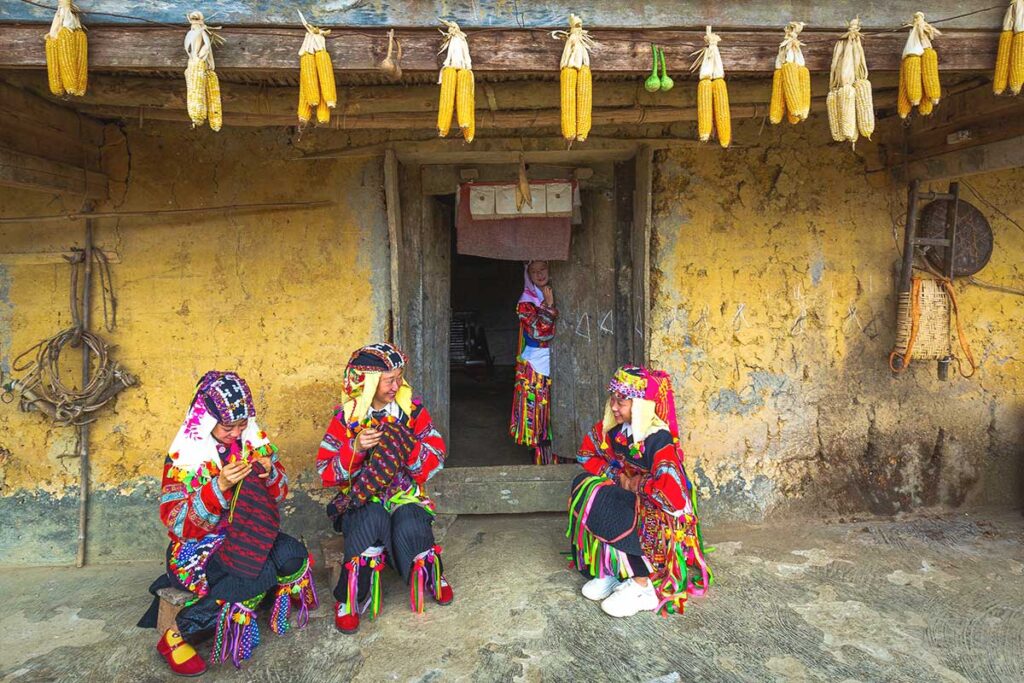
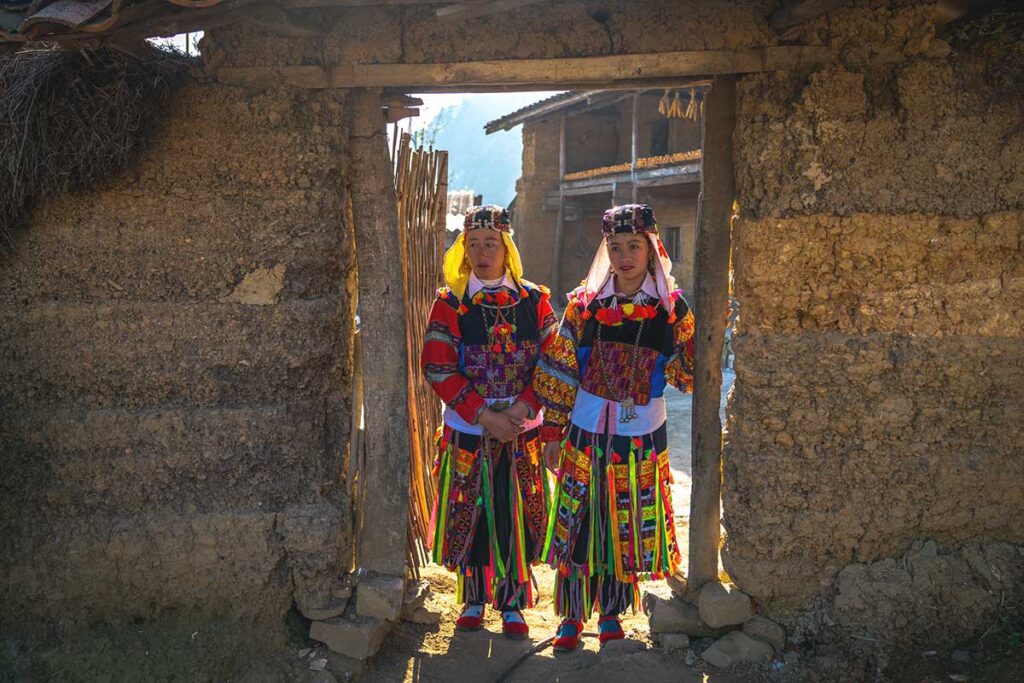
Life in Lo Lo villages revolves around farming and handicrafts, with families growing corn, rice, and vegetables on the steep mountain slopes. They also practice ancestor worship and celebrate unique rituals and festivals, including special drum ceremonies during the Lunar New Year.
One of the best places to experience Lo Lo culture is Lo Lo Chai Village, located near the Lung Cu Flag Tower. This small village has preserved its traditional clay houses, and several Lo Lo-run homestays offer travelers the opportunity to stay overnight in an ethnic home.
Hmong People – The largest ethnic group in Ha Giang
The Hmong are the largest ethnic group in Ha Giang, and many villages in Lung Cu Commune are Hmong settlements. Unlike the Lo Lo, who are a small group, the Hmong are spread across northern Vietnam and neighboring countries like Laos and China. They are known for their distinctive embroidered clothing, with women often wearing pleated skirts, silver jewelry, and headscarves.
Hmong families rely on farming, livestock, and weaving for their livelihoods. In many villages, you will see women spinning hemp and weaving textiles, a skill passed down through generations. The Hmong have a strong community structure, with village elders and clan leaders playing an important role in decision-making.
Hmong houses in Lung Cu are also built from yellow clay, a traditional construction method that helps regulate temperature in both hot summers and cold winters. Ma Lé Village, located near Lung Cu, is a great place to explore traditional Hmong life, especially on Saturdays when the weekly market takes place.
The changing landscape of Lung Cu’s villages
While many villages in Lung Cu remain traditional and untouched, some have been influenced by the rise of tourism. In recent years, some ethnic families have transformed their homes into homestays, while others have sold their properties to investors from Hanoi and other lowland areas, who now run guesthouses and restaurants.
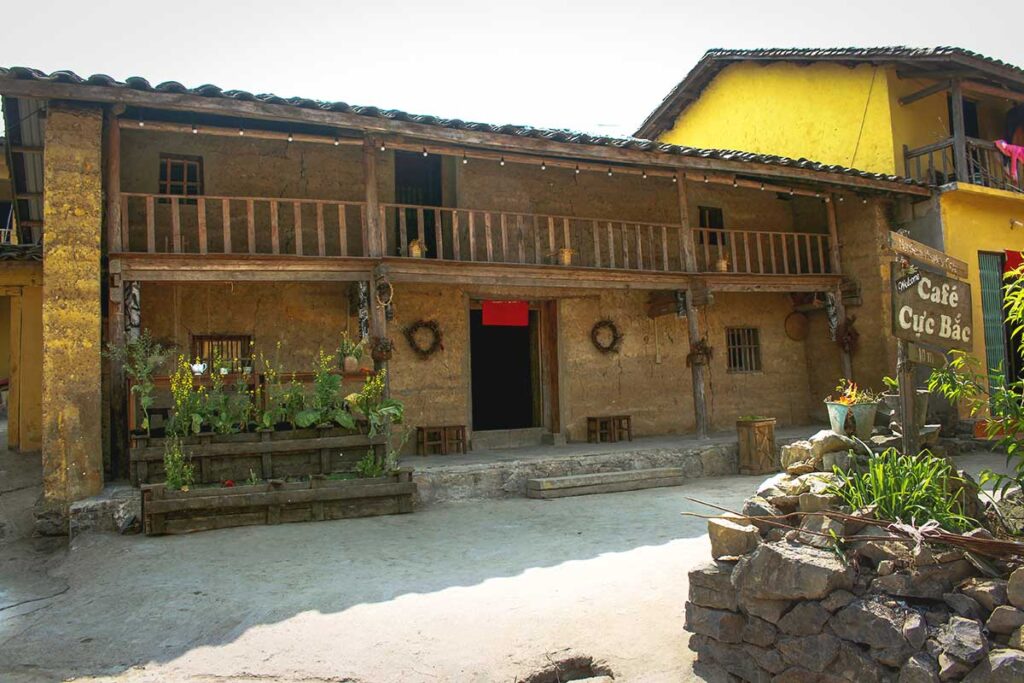
Cang Tang Village is the most popular village for homestays, with several guesthouses offering overnight stays in traditional stilt houses. Then Pa Village also has a few homestays, though it remains quieter and more traditional. However, not every village has homestays, and visiting these untouched communities offers a more genuine and unfiltered glimpse into local life.
If you want to experience the most authentic side of Lung Cu, consider visiting villages that have not yet been transformed by tourism, where families continue their traditional farming lifestyles and daily routines. These places offer a window into the past, showcasing a way of life that has remained unchanged for generations.
Lung Cu Pagoda
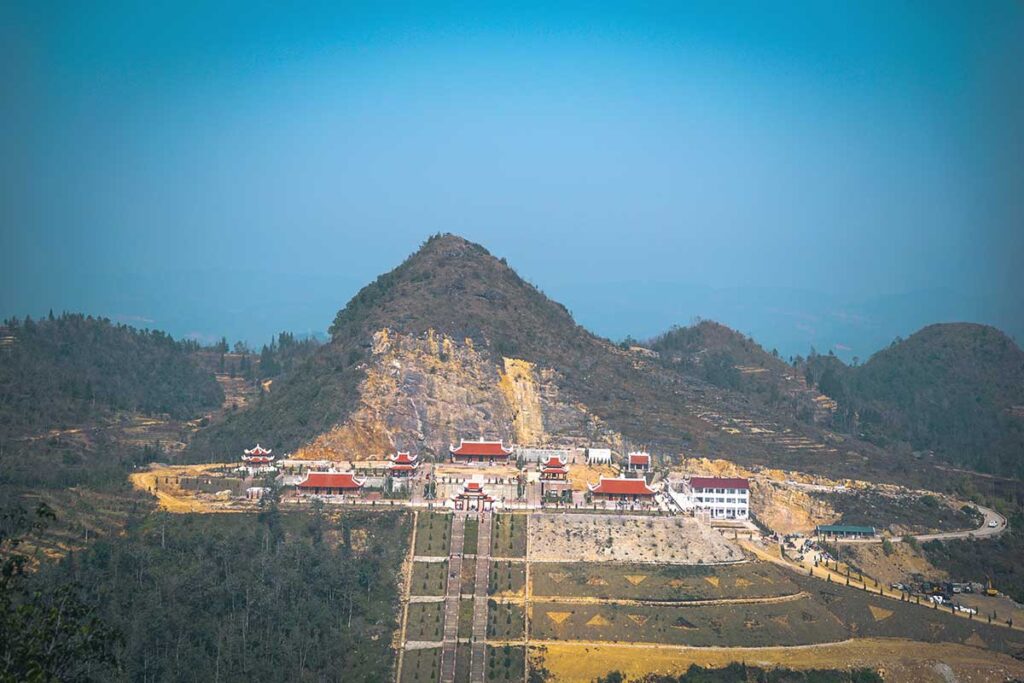
A massive Buddhist temple complex now stands on a mountain opposite the Lung Cu Flag Tower, built on a 75-hectare site with large Buddha statues and a grand staircase. Constructed in 2016 with an 800 billion VND budget, the project aimed to create a spiritual tourism site but has sparked controversy. Large sections of the mountain were destroyed, altering the natural landscape and drawing criticism for environmental damage.
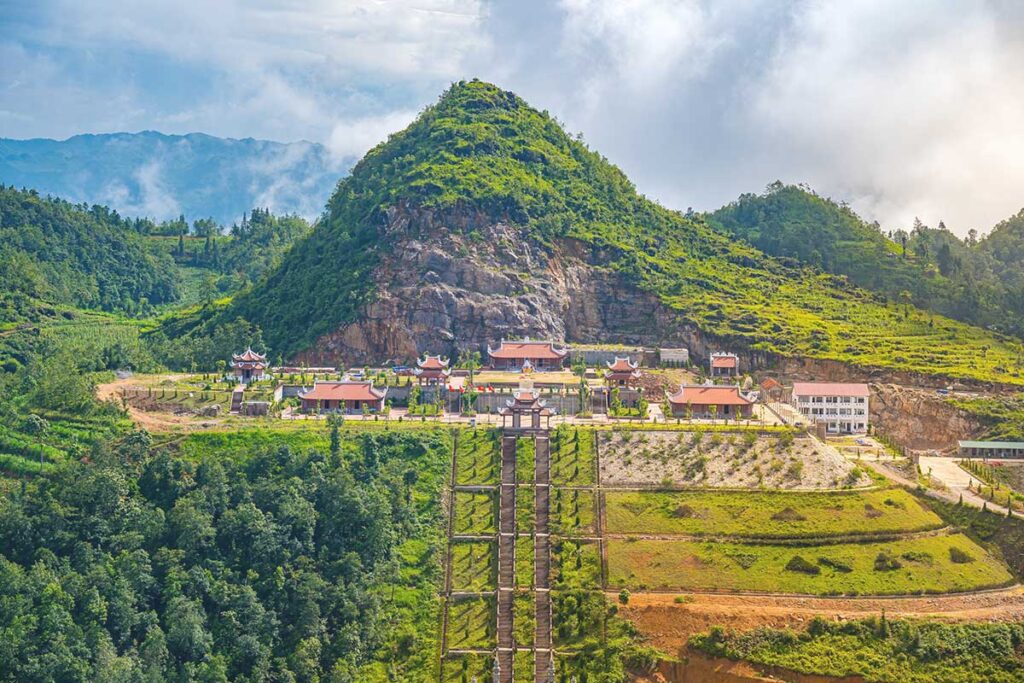
Built without full approval or environmental assessments, the pagoda contrasts with Ha Giang’s untouched scenery and ethnic culture. While some appreciate its scale and views, others see it as an unnecessary development. If you’re interested in modern Buddhist sites, it may be worth a visit, but those seeking an authentic Ha Giang experience might prefer to focus on its natural beauty and ethnic villages.
How to get to Lung Cu
As the northernmost point of Vietnam, Lung Cu is not a destination travelers visit on its own. Instead, it is typically included as part of the Ha Giang Loop, a famous multi-day motorbike or car route through Ha Giang’s spectacular mountain landscapes. The journey to Lung Cu starts in Ha Giang City, the main gateway to the province, which is only accessible by road.
Tip: Visit Lung Cu Flag Tower with a guided tour
Lung Cu Flag Tower is the northernmost point of Vietnam and part of many Ha Giang Loop tours. Our tours include all transfers, local guides, and a flexible route that takes you there. Check out all Lung Cu tour options here.
From Hanoi to Ha Giang City, you have a few options:
- Sleeper buses (overnight) – The most popular and budget-friendly option, taking around 6 to 7 hours.
- Limousine vans (daytime) – More comfortable but slightly more expensive.
- Private car – The most convenient and flexible way, but also the most costly.
Once in Ha Giang City, you can start the Ha Giang Loop, which passes through Dong Van, from where it’s a 25 km detour to Lung Cu. Travel options include:
- Car or Jeep – The most comfortable and safest option, ideal for groups or those who prefer not to ride motorbikes.
- Motorbike – The most popular option, offering a thrilling ride through breathtaking scenery. However, it is only recommended for experienced riders with an international license.
- Easy Rider (Motorbike with Guide) – A great alternative where you sit on the back of a motorbike while a local guide drives and shows you the best sights.
Accommodation
The most popular place to stay in the area is actually in Dong Van town and not in Lung Cu. There are however accommodation in the area, mostly homestays. A great thing about staying around Lung Cu is for a more authentic experience than staying in Dong Van. All the homestays here are of the ethnic minorities living here and staying at their place will give you a unique look into their culture.
Recommended homestays in Lung Cu
- Lolo Eco House – For a truly unique local experience, stay here. Practical traditional house which is beautifully situated. Run by an ethnic minority who provides good service.
- Sister’s House – The rooms of this homestay are very basic, but it feels very authentic, hidden in the back of the village of Lung Cu. The family is incredibly friendly and there is also a great common area with a pool table.
- Homie homestay – Located in Lung Cu in a traditional yellow clay house and hosted by a nice family.
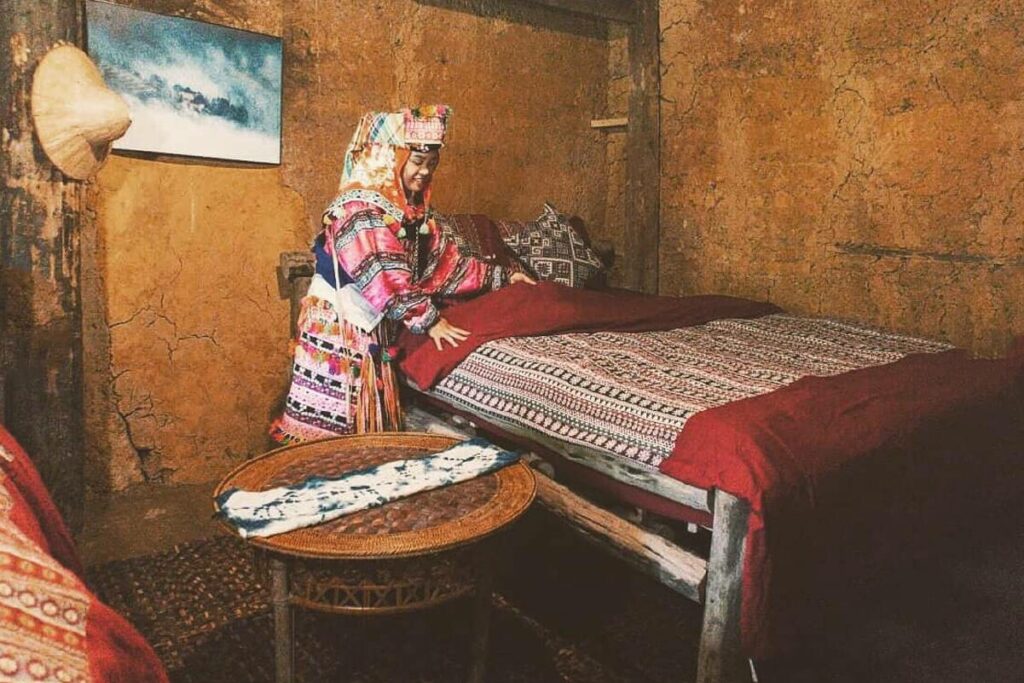
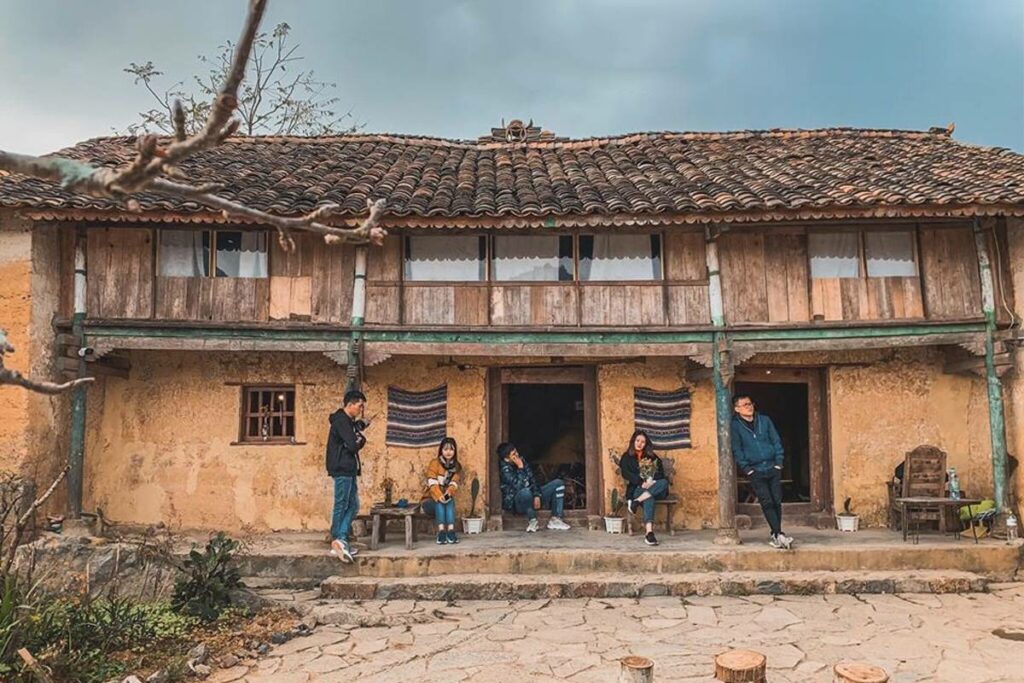
Best time to visit
Lung Cu can be visited all year round, however, like the rest of Ha Giang, the mountains can some times be foggy with limited visability. There is more change on rain during the summer month, especially the months July and August. During the winter months of December and January it can get quite cold here.
Is Lung Cu Flag Tower worth a visit?
Yes, but not just for the flag tower itself. While the Lung Cu Flag Tower is an important national symbol and offers great views, the real highlight of visiting Lung Cu is the scenic journey to get there. The road from Dong Van or Sa Phin takes you through some of the most breathtaking mountain landscapes in Ha Giang, passing through remote ethnic villages and valleys along the way.
The Lo Lo Chai Village and other traditional settlements near Lung Cu offer an authentic cultural experience, making the trip much more than just a stop at the flag tower. If you’re already exploring the Ha Giang Loop, Lung Cu is a worthy detour for both the views and the cultural encounters.
